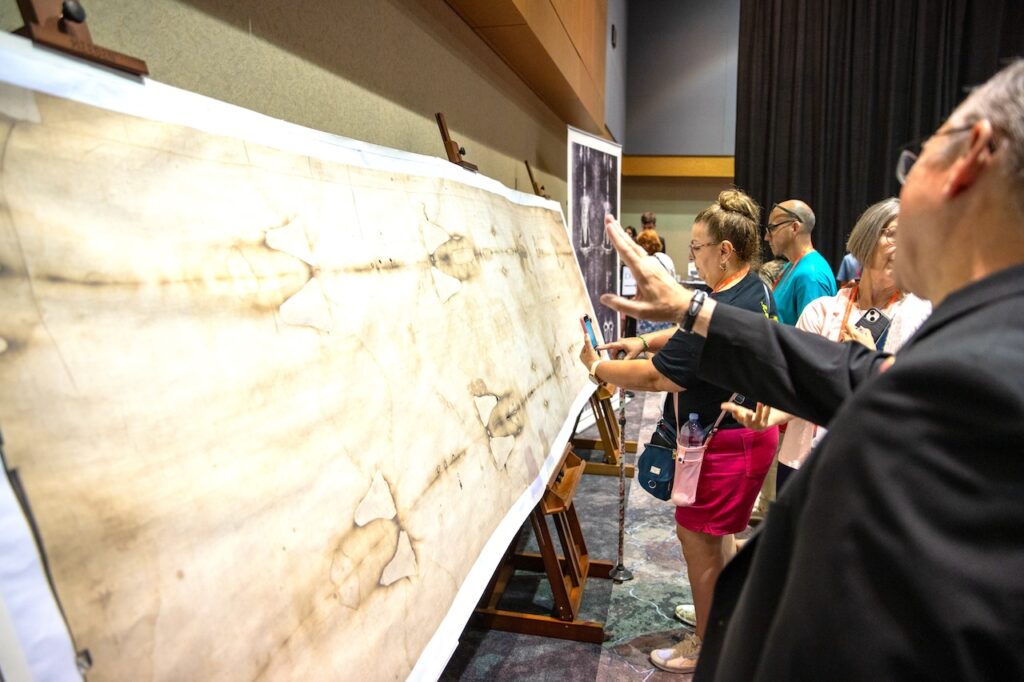Shortly after I was ordained a bishop, I attended the orientation for new bishops in Rome. At the seminary where I was staying was a display about the Shroud of Turin – the cloth in which the body of Jesus was wrapped following his crucifixion. The exhibit included a large, 3D-image which, as one moved, showed the negative image of the body of the man on the Shroud.
There are some remarkable qualities to the Shroud which are unexplained even after scientists have examined it. The Shroud is an extraordinary relic, an unknown phenomenon. It has some miraculous aspects that cannot be explained in any other way – miraculous in terms of the image that is on it.
Most scientists who have studied it concur that the only way that image could have been imprinted was if there was a three-dimensional body in the Shroud which radiated light outwards. The best hypothesis that scientists could propose as the cause of the image is that the light and energy of that body put the image onto the Shroud.
Because of technology, scientists can explore this phenomenon in multiple ways. The first evidence that there was something extraordinary about it surfaced when photo technology produced the negative that revealed a real human being had been wrapped in the Shroud.
The negative looks like a positive and the positive like a negative. The technology analyzed the image and what they discovered is that the image in the Shroud changes depending on the distance the figure was from the cloth, and they can’t explain how that occurred.
During a TED talk 11 years ago, Barrie Schwortz, a technical photographer who was raised as a traditional, Orthodox Jew, explained that although he was a “skeptic,” he was part of a team of experts in medicine and science the Vatican asked to examine all aspects of the Shroud.
The team, according to Schwortz, determined the image was not painted nor was it the result of some ancient photographic technique. The only way they explained it, he said, was that there was light radiating from the body of the person surrounded by the Shroud and always radiating in multiple directions.
The body caused some change in this fabric on which its image with 3D qualities was impressed. The photographic negative provides a full image of a man’s body with stains that indicate torture and suffering.
The previous issue of The Catholic Virginian carried an article: “New Insights on Blood Evidence from the Turin Shroud Consistent with Jesus Christ’s Tortures.” The study concluded that the presence of creatinine particles with ferritin, which are often a by-product of muscle contractions, “confirms, at a microscopic level, the very heavy torture suffered by Jesus” that appears on the Shroud.
There was a mystery: Why was the blood on the Shroud still red? Dried blood turns brown or black. However, when the blood itself is infused with the chemical the body produces when one is under extreme stress, it affects the blood to where it does not turn brown or black but stays red.
Scientists have also determined that the blood type found on the Shroud is AB. O negative is a universal donor; AB is a universal recipient. This fact is symbolically significant. Jesus took upon his shoulders the sins of the world; he took the punishment on himself, accepting the culpability of all. As St. Peter wrote, “By his wounds you have been healed” (1 Pt 2:24).
As Catholics, we know that God can act outside of nature through the extraordinary, e.g., apparitions and miracles, as well as within nature. However, no one’s salvation hinges upon accepting or not accepting these phenomena. The Church, other than allowing for reverence and devotional practices around it, does not require belief in the authenticity of the Shroud.
However, consider what Pope Benedict XVI said in a 2010 visit to Turin during which he venerated the Shroud:
“It speaks with blood, and blood is life! The Shroud is an icon written in blood; the blood of a man who was scourged, crowned with thorns, crucified and whose right side was pierced. The image impressed upon the Shroud is that of a dead man, but the blood speaks of his life. Every trace of blood speaks of love and of life.”
We pray that the message of the Shroud speaks to us of Jesus’ sacrificial love. May it help us better understand the magnitude of that love and sustain us as we take up our own crosses and follow him.

